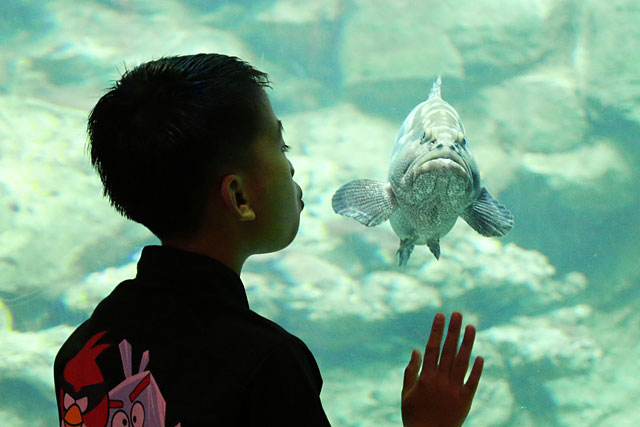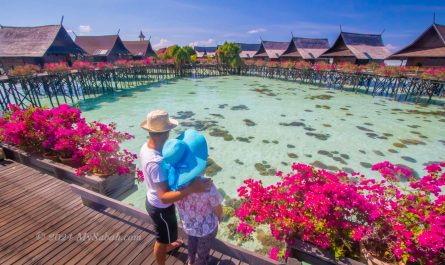Though sea covers 71% of Earth’s surface, scientists say we know our Moon better than our ocean. But there’s a mysterious but beautiful garden down below, a world which has no human settlement. Sabah is lucky as part of Coral Triangle (a.k.a. Amazon of the Sea) thriving with over 600 coral and 2,000 reef fish species. The Aquarium & Marine Museum of University Malaysia Sabah (UMS) lets us explore our ocean world without getting our hair wet.
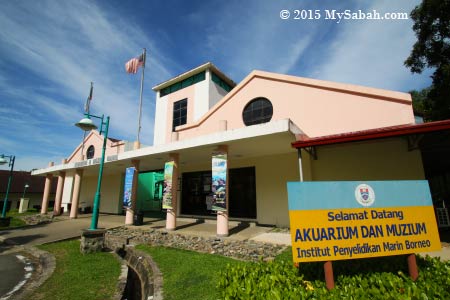
Pic: the building of UMS’s Aquarium & Marine Museum. The signage is in Malay language (translated as Welcome to Aquarium & Marine Museum, Borneo Marine Research Institute).
Managed by Borneo Marine Research Institute (BMRI), Aquarium & Marine Museum is a 2-in-1 showcase where visitors can see interesting specimens in their museum, and the live ones in aquarium. It’s not big and it takes ordinary tourists less than an hour to tour around and leave with some pictures, or it can take hours if you come with an intention to learn and leave with more knowledge.
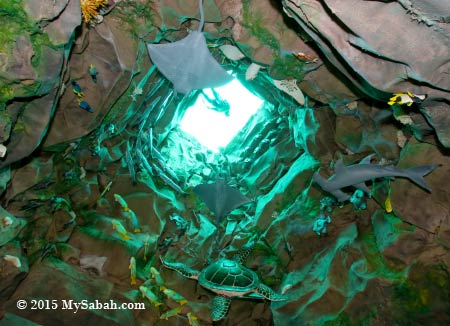
When you walk in, just look up and you will see the diorama of Sipadan Island deep dive. That reminds me of my previous wall diving trip in Sipadan. It’s a tranquil environment full of vibrant marine lives.
Marine Museum
This museum exhibits and documents some of the extraordinary specimens and flora & fauna records of Borneo ocean. The goal is to educate the public to protect our marine environment so museum won’t become the only place to see them. Most of the labels, posters and news clips are in English and Malay languages.
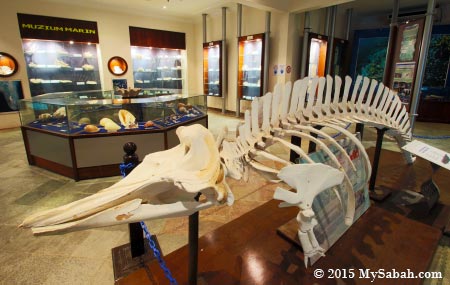
Pic: skeleton of Cuvier’s Beaked Whale (Ziphius cavirostris)
The highlight is the 4.43-Meter skeleton of Cuvier’s Beaked Whale, it’s the first record of this whale appears in Malaysia (Sabah). You also can see the preserved remains of Rough-toothed dolphin (Steno bredanensis) and 4 species of turtles from Sabah. FYI, there are 15 marine mammal species (dolphin, whale, dugong) live in the sea of Sabah and Sarawak. Do you know Irrawaddy Dolphin was used to be common in Sabah rivers?
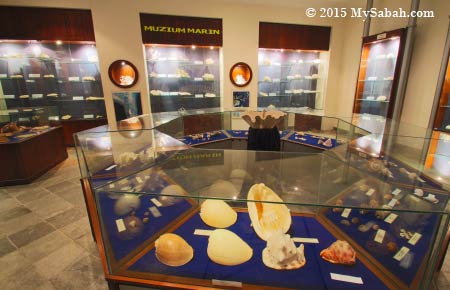
Pic: hard corals and seashells exhibition
There are many beautiful seashells displayed here. Our beaches are no longer carpeted by seashells nowadays because of beach-combing by tourists and locals, and many end up in handicraft shops and seafood restaurants too.
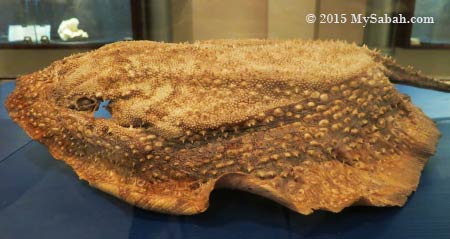
Pic: Porcupine Ray (Urogymnus asperrimus)
One of the rare specimens is the Porcupine Ray, locally known as Durian Ray, which is the only “sting-less” stingray that uses heavily spiked skin as defense mechanism. It is first found in Sabah at Banggi Island. It attracted a lot of spectators in the fish market then the researchers moved it here.
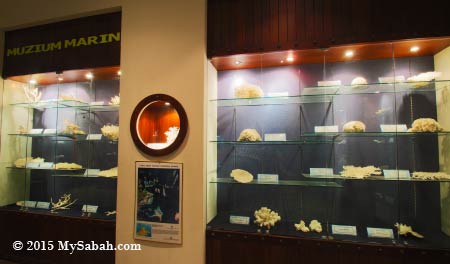
Pic: hard corals on display
The rich variety of hard corals in this gallery are mainly from Semporna and Lahad Datu. Most of them are collected from 6-week Galaxea Expedition 98 in Darvel Bay of Lahad Datu, where they identified 1 new genus and 8 new species of corals in the world (and over 100 new records in Sabah)! The 8 newly discovered coral species are on display here.
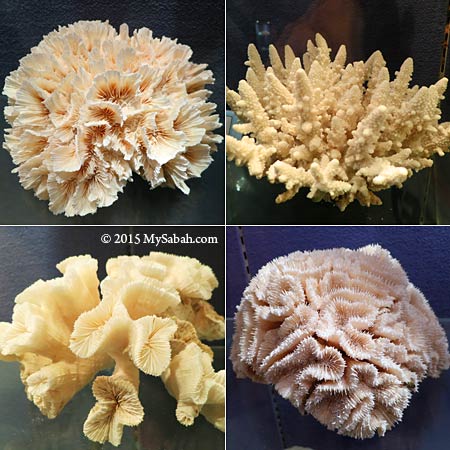
Many medicines are developed from coral reef animals and plants and 1/4 of our catch are from coral reefs, so destroying corals is same as destroying the home of seafood and our hope to cure cancer, arthritis, etc.
Aquarium
Visitors can see big and small marine lives up-close in 2 huge aquariums and couples of fish tanks and tube tanks. Is Nemo the only fish your children know? This aquarium is a fun “classroom” to show them what are squirrel fish, parrot fish, angel fish, surgeon fish, etc.
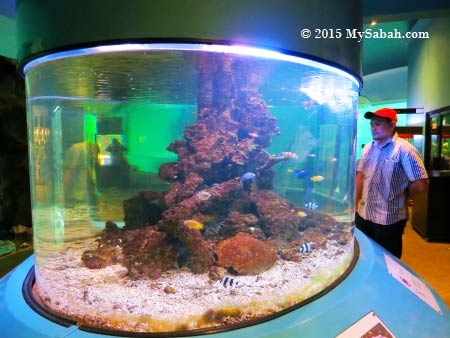
Pic: oval fish tank filled with regal blue tang, clown fish, feather star, starfish, sea cucumber, banner fish, etc.
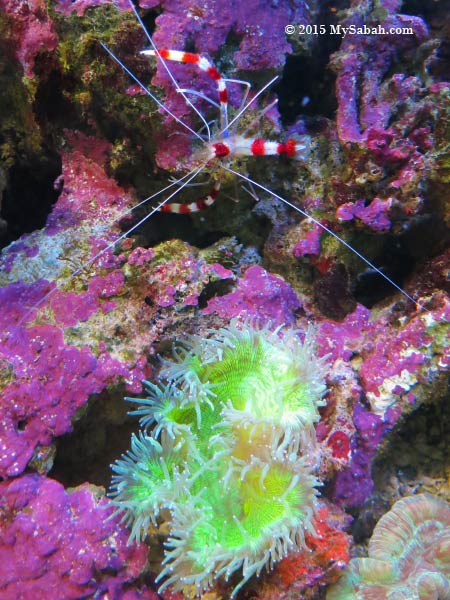
Pic: Banded cleaner shrimp and sea anemone
Cleaner shrimps help to remove parasites from fishes for free and fishes won’t eat them. For fun, some scuba divers open their mouths to let cleaner shrimp to get in cleaning their teeth. This is just one of the wonders in ocean life.
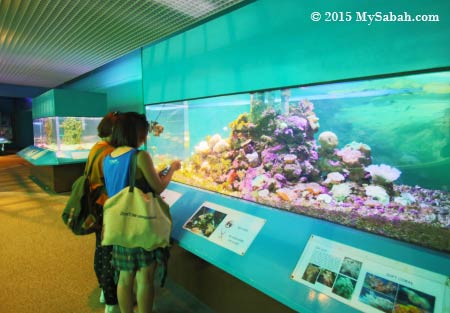
In 3 hours, I saw many tourists from Hong Kong, China and Australia in the aquarium. Their mouths opened wide when their tour guide told them that corals are animals, not plant. Besides fishes, you can see hard and soft corals in the tanks.
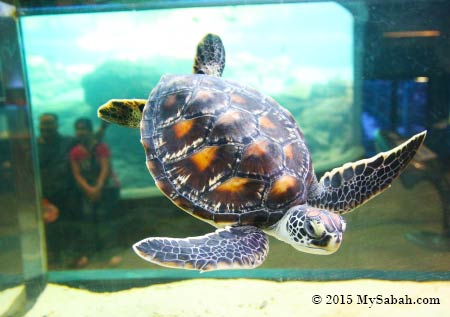
Pic: A 16-month old Green Turtle adopted from turtle hatchery at Borneo Divers and Seasports Mabul, Semporna.
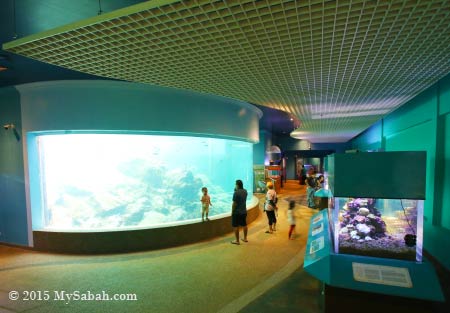
Many kids were excited by the exhibition and fish tanks. Their curiosity peaked and kept asking questions, and their parents busy answering patiently (by peeking at the labels), what a great place to play and learn for family.
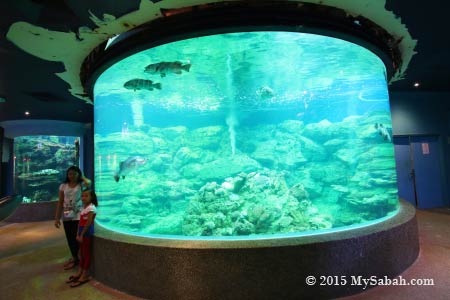
This deep reef tank holds 11,000 Liters of seawater and houses high value commercial species such as groupers, seabass and snapper.
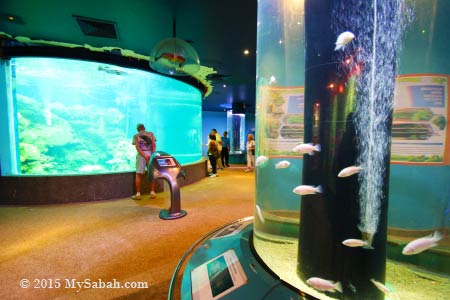
The feeding time is between 3:30pm and 4pm, the best time to see all the fishes come out of their hiding place for food.
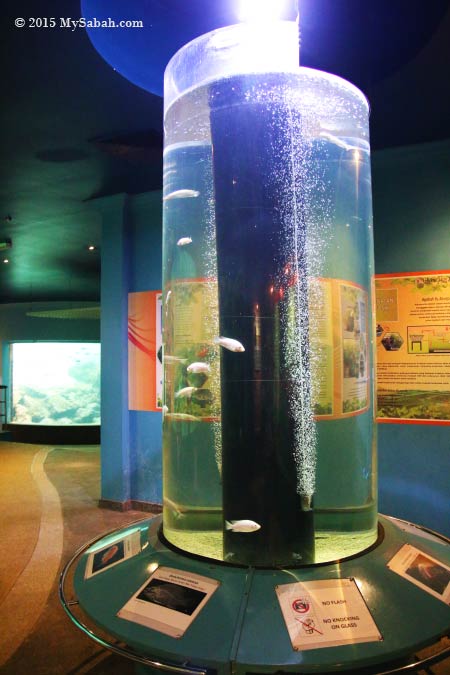
The tube tanks, which house Humphead Wrasse, Napoleon Wrasse and Nile Tilapia, look like incubator capsule of space lab in science fiction movies.
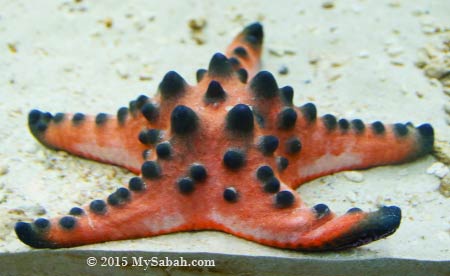
Pic: a Chocolate Chip Star (yes, it’s really named like that), keen to give it a lick? LOL
Starfish has amazing regenerating ability. It’s able to re-grow arms that are lost. The broken arms may also regenerate to another complete starfish!
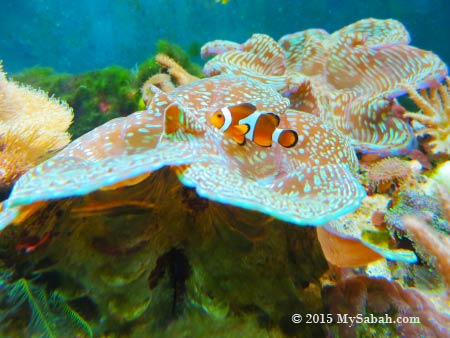
Pic: Nemo and giant clams
Clownfish (Nemo) can change sex from female to male, a characteristic known as Protandrous Hermaphroditism. Sabah has 7 out of 9 giant clam species in the world, due to over-fishing, it’s hard to see one in the wild.
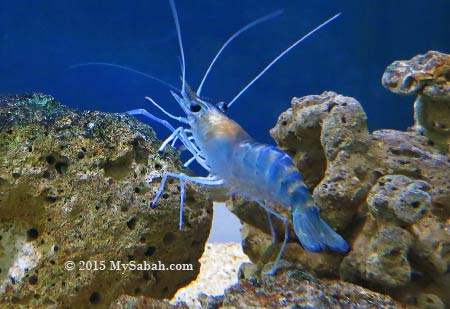
Pic: UMS also conducts research on farming of Giant Freshwater Prawn (Udang Galah) for commercial purpose.
Giant Groupers
Guess which fish attracts the most attention? It’s not Nemo but the hybrid grouper, which is a cross between tiger grouper (Epiphelus fuscoguttatus) and giant grouper (Epinephelus lanceolatus), the first hybrid grouper (named as TGG hybrid) in the world. This is one of the BMRI projects to improve high-market-value grouper species in fish farm.
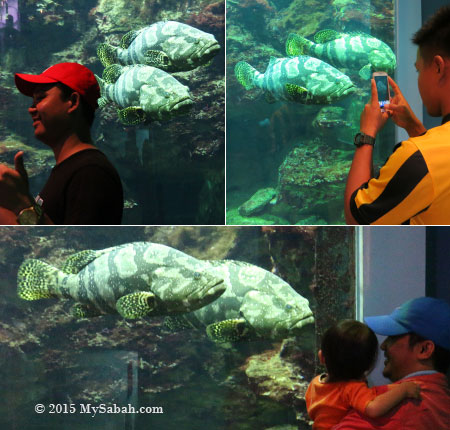
Many tourists lined up to take photo with them. These two big groupers are very cooperative and “friendly”, as if they enjoy being photographed. Since they are hybrid, you won’t find this fish in the wild. Well, groupers not only look good on plate.
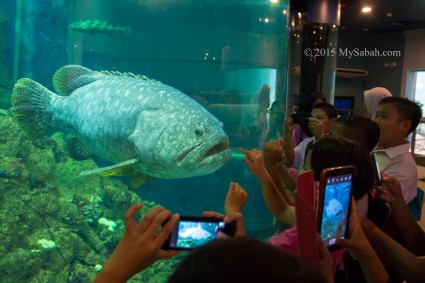
The true superstar in this aquarium is a 15-year-old Giant Grouper (Epinephelus lanceolatus), which weighs 60-70 Kg and about 4 feet long.
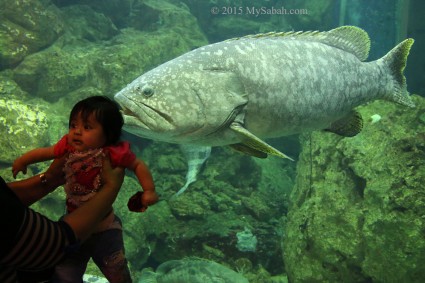
There are also Tiger groupers, Orange-spotted groupers and Seabass in another tank.
Other hybrids that were successfully produced are, Orange-spotted grouper x Giant grouper (E. coioides x E. fuscoguttatus) and Mouse grouper x Tiger grouper (Cromileptes altevelis x E. fuscoguttatus).
Other Things to Do
Visitors can do other fun activities in the aquarium.
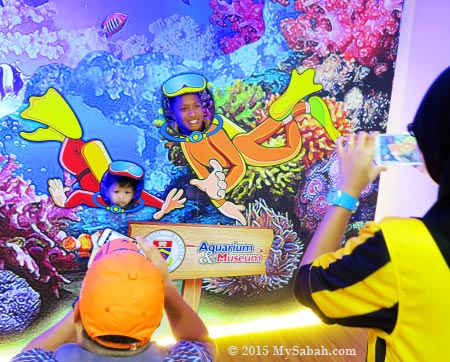
Pic: taking photo in stand ins in Ocean Outreach Corner. The 110 Sq. Meter Ocean Outreach Corner is a small room suitable for group activity. There are some informative posters about fishery and conservation such as fishing gears of Malaysia, commercial rays, aquaculture, hatchery projects, sea turtle research and academic marine programs.
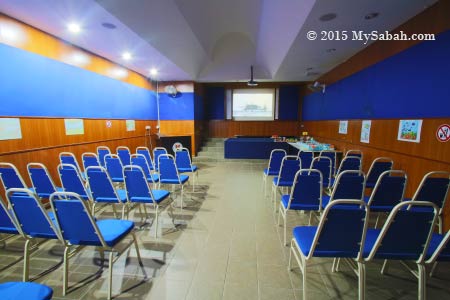
Pic: Mini Theater in the Aquarium
You can watch video about marine biodiversity of Sabah in this 50-seat mini theatre equipped with audio-visual facilities.
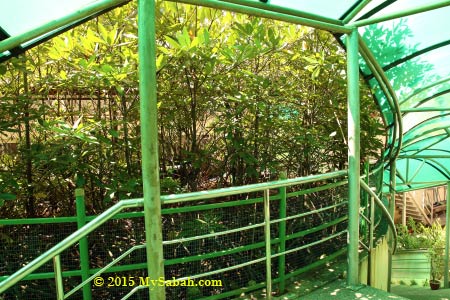
Pic: mangrove walk
There’s a mangrove walk section at the exit of aquarium, with some dense mangrove plant (Rhizophora spp.) in a muddy pond. Though mangrove is a swamp, it’s vital for marine life because over 70 fish species such as grouper use mangrove as a feeding, breeding and nursery area.
Sea View & UMS Jetty
I noticed a few tour buses didn’t leave the university after the visit, they brought their tourists to another side, so I followed them and found a nice beach.
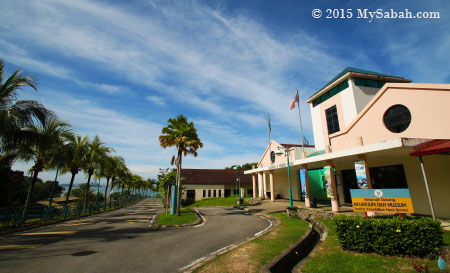
Pic: the aquarium is situated next to a scenic seaside (see left).
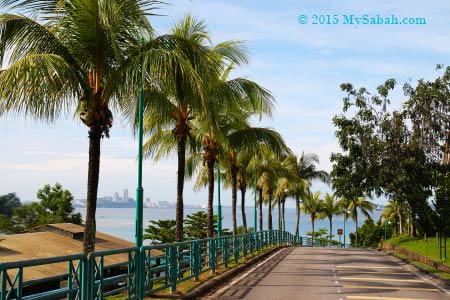
Pic: you can follow this road to walk 300 Meters to the beach. You already can see Kota Kinabalu City (KK) from the road.
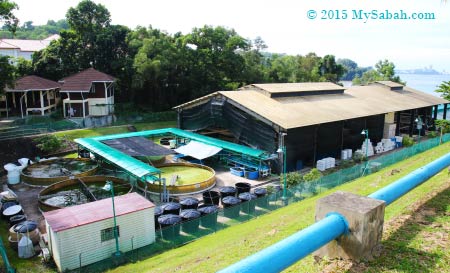
Pic: you will pass by the aquaculture hatchery of BMRI along the way
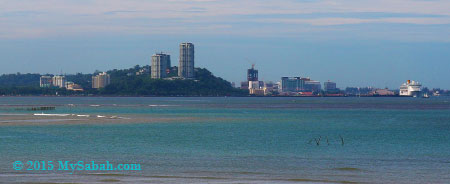
Pic: view of KK from the beach of UMS
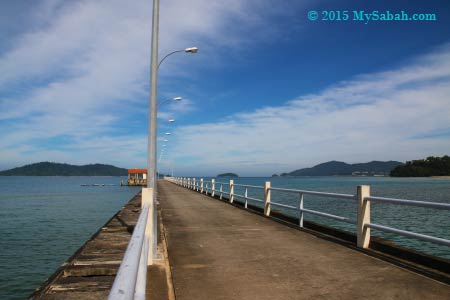
Pic: At the end of the road is UMS jetty. The gate is locked but you still can have a scenic view of islands, KK and Sepanggar Bay.
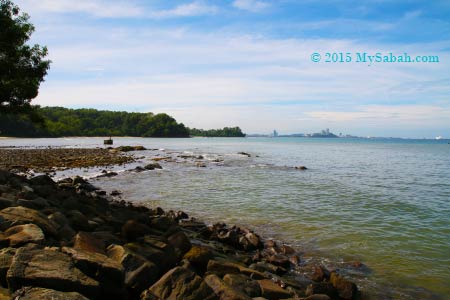
Pic: The rocky beach next to UMS jetty. I joined other tourists to enjoy the sea view and breeze there.
More Info & Contact
The following are some useful info for visitors:
| Ticket / Fee (inclusive of 6% GST) | Malaysian | Foreigner |
|---|---|---|
| Child / Student (4-17 years) | RM5 | RM10 (≈US$2.80) |
| Adult (18 & above) | RM10 | RM20 (≈US$5.70) |
| Senior Citizen | RM5 | RM10 (≈US$2.80) |
| Camera Pass (optional) | RM5 | RM10 (≈US$2.80) |
Last Updated: Nov 2015
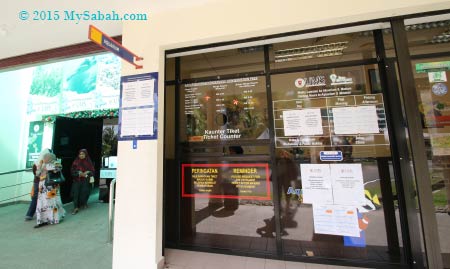
Pic: ticketing counter next to entrance of UMS Aquarium & Marine Museum
Opening Hours
UMS Aquarium & Marine Museum will be closed for renovation and maintenance from 28 August 2017 to 13 November 2017.
Mon -Thu, Sat: 9am – 12:30pm, 2pm-4pm
Fri: 9am-11:30am, 2pm-4pm
Sun & Public Holiday: closed
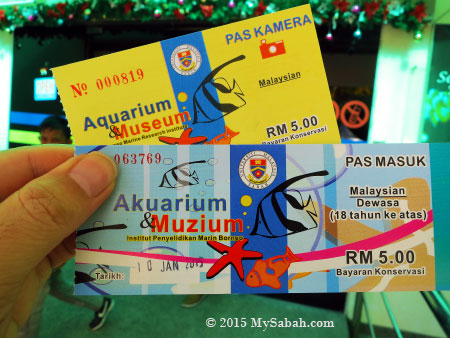
Pic: the tickets to the aquarium. You can take photo (without flash) in the aquarium if you buy the Camera Pass.
Address (see Location Map): University Malaysia Sabah, Borneo Marine Research Institute, Jalan UMS, 88400 Kota Kinabalu, Sabah, Malaysia.
Tel: +60 88-320 121
E-mail: bmru@ums.edu.my
Website: www.ums.edu.my
How to get there
Aquarium & Marine Museum is located in the campus of UMS (see Location Map) and about 6 KM away from KK. It is open to public and you can walk-in during opening hours without prior arrangement. The aquarium is about 2 KM away from the entrance of UMS, so I advise you to go there by taxi or own transport.
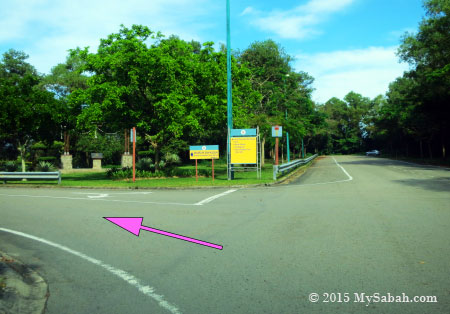
Pic: the junction to the Aquarium
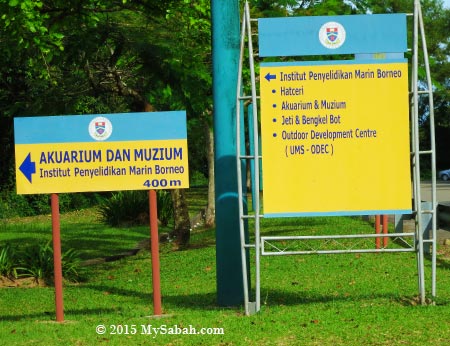
Pic: the direction signage is in Malay language. If you see the words “Akuarium dan Muzium” (means Aquarium & Marine Museum) and “Institut Penyelidikan Marin Borneo” (means Borneo Marine Research Institute) on it, you are on the right way.
More Photos
You may browse my photo album for more photos:
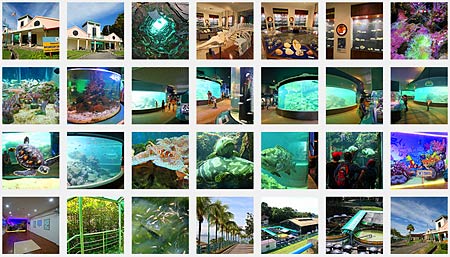
UMS Aquarium & Marine Museum is worth a visit, especially for family and student groups. Though it’s not a world-class oceanarium, the aquarium can give you a good overview of ocean biodiversity in Borneo. To impress the visitors more, it’ll be great if the aquarium has more variety of popular marine animals such as sharks, seahorses, eel, manta ray and probably… mermaid, haha.
Photos taken in Kota Kinabalu, Sabah, Malaysia Borneo
